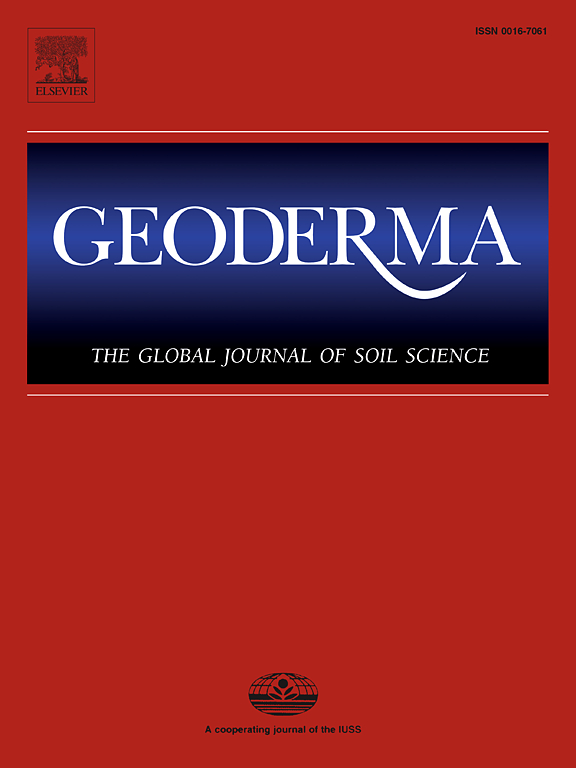Magnitudes, patterns, controls and mitigation potentials of net ecosystem carbon balances across wetlands in China
IF 5.6
1区 农林科学
Q1 SOIL SCIENCE
引用次数: 0
Abstract
China contains Asia’s largest wetlands, which include diverse wetland types, e.g., peatlands, marshes and mangroves; these wetlands are found from inland to coastal regions. Over the past four decades, considerable amounts of natural wetlands have been drained, thus severely decreasing their carbon (C) sequestration ability. Recent rewetting has been initiated to restore wetland ecosystem services and mitigate carbon dioxide (CO2) emissions. However, the magnitudes, patterns, controls and mitigation potentials of annual net ecosystem C balances (NECB) have not been adequately studied, leading to large uncertainties in predicting wetland C cycles under climate change and anthropogenic activities across different wetlands in China. These influencing factors include the combinations of vertical net ecosystem exchange of CO2 (NEE) and horizontal C removal through biomass harvest, as well as dissolved organic and inorganic C (DOC and DIC) exports. Here, using the annual measurement of NECB from 148 sites across different wetlands in China, we found that the annual NECB varied widely from –9413 to + 8760 kg C ha−1 yr−1; these fluxes were collectively influenced by wetland status, wetland location, and wetland type. Drainage turned natural wetlands from net C sinks to net C sources (p < 0.05), regardless of whether wetlands were inland or coastal, while rewetting significantly (p < 0.05) reversed the net C loss trends from drained wetlands to net C uptake in rewetted wetlands. Coastal wetlands had significantly greater (p < 0.05) annual C uptake than inland wetlands, with coastal mangroves exhibiting the highest uptake rates. Eighty percent of the spatial variations in the annual NECB were explained (p < 0.0001) by the spatial variations in the mean annual temperature (MAT) and water table depth (WTD) across different wetlands in China. Scenario analysis showed that drained wetlands should be rewetted promptly; postponing rewetting causes larger emissions from continued C losses from drained wetlands.

中国湿地生态系统净碳平衡的大小、模式、控制和减缓潜力
中国拥有亚洲最大的湿地,包括泥炭地、沼泽和红树林等多种湿地类型;这些湿地从内陆到沿海地区都有。在过去的40年里,大量的天然湿地已经被排干,从而严重降低了它们的碳(C)固存能力。最近,为了恢复湿地生态系统服务和减少二氧化碳的排放,已经启动了湿地再湿润。然而,由于对年净生态系统C平衡(NECB)的规模、模式、控制和减缓潜力的研究还不够充分,导致中国不同湿地在气候变化和人为活动下的湿地C循环预测存在较大的不确定性。这些影响因素包括垂直生态系统净二氧化碳交换(NEE)和通过生物量收获的水平碳去除,以及溶解有机和无机碳(DOC和DIC)出口的组合。通过对中国不同湿地148个站点的年NECB测量,我们发现年NECB在-9413 ~ + 8760 kg C ha - 1 yr - 1之间变化很大;这些通量受湿地状况、湿地位置和湿地类型的共同影响。排水将天然湿地从净碳汇转变为净碳源(p <;0.05),无论湿地是内陆还是沿海,而再湿润显著(p <;0.05)将湿地净碳损失趋势逆转为再湿润湿地的净碳吸收趋势。滨海湿地的p <显著高于滨海湿地;0.05)年碳吸收量高于内陆湿地,沿海红树林的碳吸收量最高。每年NECB中80%的空间变化都得到了解释(p <;中国不同湿地年平均温度(MAT)和地下水位深度(WTD)的空间变化与0.0001)的差异。情景分析表明,已排干的湿地应及时补湿;推迟再湿润会导致排水湿地持续的碳损失产生更大的排放。
本文章由计算机程序翻译,如有差异,请以英文原文为准。
求助全文
约1分钟内获得全文
求助全文
来源期刊

Geoderma
农林科学-土壤科学
CiteScore
11.80
自引率
6.60%
发文量
597
审稿时长
58 days
期刊介绍:
Geoderma - the global journal of soil science - welcomes authors, readers and soil research from all parts of the world, encourages worldwide soil studies, and embraces all aspects of soil science and its associated pedagogy. The journal particularly welcomes interdisciplinary work focusing on dynamic soil processes and functions across space and time.
 求助内容:
求助内容: 应助结果提醒方式:
应助结果提醒方式:


